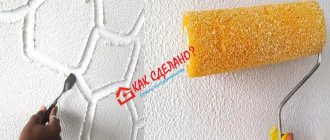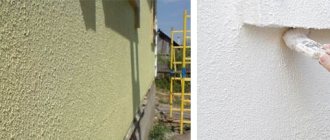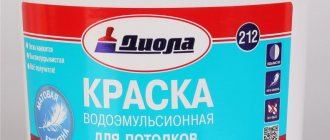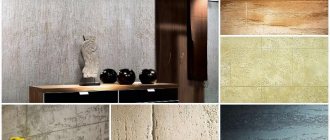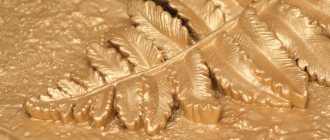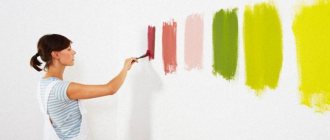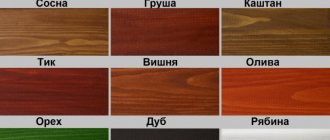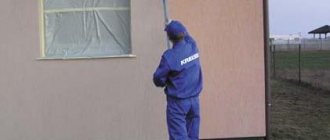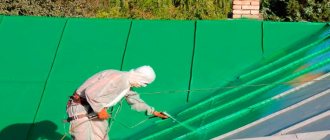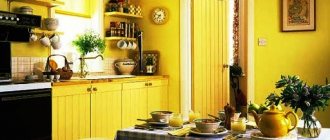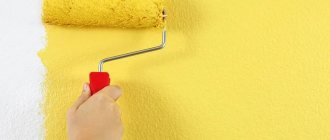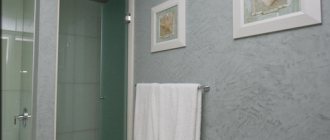Standard decorative coating in high-tech style with a metallic effect
Looking at the interiors of modern houses and apartments, you will notice that paint is increasingly being used for decoration, replacing such popular options as wallpaper and tiles. Compared to other types of coatings, the substance has many advantages:
- it gives more opportunities to implement ideas in interior decoration;
- color remains for a long time due to improved characteristics;
- the coating is not affected by moisture, and mold does not grow on it after painting. The walls can be washed;
- has anti-corrosion properties: if you apply it to metal, rust will not appear;
- does not move away from the wall;
- looks stylish and allows you to create a cozy atmosphere in the room;
- Suitable for bedroom, living room, kitchen, bathroom, offices or public places. Easy to clean;
- production is carried out by companies from around the world, so you can find an option that suits the price.
Decorative paint
Decorative paint
The material is available in a wide range of colors: white, vanilla, black, red, green, blue and other shades of each color. Separately, it is worth highlighting gold and copper, with an imitation of a metal surface. Often, when decorating rooms, they tend to lighten the walls, so they use light-colored coatings.
Decorative paint
Decorative paint for fireplace
Decorative wall paint is odorless and dries quickly, the material is non-toxic. This is a textured or smooth coloring composition that, when applied, allows you to create a pattern. It differs from paint and varnish products in its thickness and viscosity, which are achieved due to the presence of special additives in the composition. This coating, which consists of several layers, is used for the final finishing of walls and allows you to create unusual textures, giving the room individuality.
Decorative paint
Decorative paint
What is paint decor? What's all the salt?
Decorative is a paint with various additives used for the final decorative finishing of walls. It differs from conventional paints in its greater viscosity and density, which appears due to the addition of special substances that create an original coating.
The use of this material allows you to obtain any texture and pattern when decorating walls. Unlike conventional paints, which give a strictly defined effect, decorative paints leave room for imagination - the final result will depend on the method of application and the thickness of the final layer.
Types of decorative paints
First of all, decorative paints are divided according to destination:
- Exterior paints.
- Paints for interior decoration.
The most popular classification of such paints is based on the type of film-forming substance included in the thickener. There are 4 main types:
Water-based
A special feature of this type is the creation of a coating that is resistant to moisture. If moisture gets on a wall painted with water-based paint, it simply evaporates without penetrating inside. Water-based coating is non-toxic and fireproof, suitable for almost any coating - with the exception of adhesive and varnished surfaces.
Acrylic
The most popular type of decorative paint. For their production, acrylic resins are used, which provide the paints with increased strength and elasticity. Acrylic paints retain color for a long time, but they are not recommended for use in places with high humidity.
Alkyd
Mainly used as protective coatings in areas with high humidity and temperatures. The composition includes an alkyd resin, which provides increased resistance to the coating.
Such paints retain their bright color for a long time, but have a strong and unpleasant odor, which makes working with the paint difficult. Also, alkyd resin can be harmful to health, so such paints are used mainly for exterior finishing work or in well-ventilated or technical rooms.
Latex
Latex paints contain rubber, which forms a durable elastic film. Due to the use of rubber, latex paints are resistant to ultraviolet radiation and protected from moisture. The elastic film allows you to apply latex paint to any substrate - due to its elasticity, the coating easily follows any relief.
Possible invoice options
The choice of textures of structural paint is limited, there are several main names, these are:
- "mizuri";
- "relief";
- "Marseilles wax";
- "wet silk";
- "Atakama".
They all have different properties, give very different visual effects, and have differences in application.
Relief
“Relief”, which contains large solid particles, creates the texture of waves, “bark beetles”, cracking, all kinds of smudges, etc. Available in several tones, applied with a roller or spatula.
Mizuri
“Mizuri” - performed using acrylic filler and modified starch. It is used to make textured or even planes, smooth wavy elements. There are many color options, the finished wall comes out with a characteristic gloss, and is applied exclusively by hand.
Marseille wax
“Marseille wax” is a name for coloring mixtures with a wax filler. When the surface is ready, it resembles an aged but shiny stone, with characteristic light and dark fragments. The coating perfectly protects against fumes and excessive humidity, and is suitable for decorating elite, luxurious premises.
Wet silk
“Wet silk” contains cotton, cellulose fibers, and polymer dyes. The finished wall has an average degree of “volume”, but the patterns on it shimmer beautifully, reminiscent of silk, velvet, velor, etc. Different brands are made in different tones.
Atacama
“Atacama” comes out the roughest, as it contains quartz sand. A plane decorated with this material shines like metal, an old mirror, a sheet of steel, and shimmers under the influence of lighting.
Advantages and disadvantages of paint in interior design
Advantages of the material:
- Durability and fire resistance . When applied correctly, decorative paints will retain their bright color for a long time - compared to conventional wallpaper, their service life is twice as long.
- Environmental friendliness . Most of these paints are made from natural ingredients and are absolutely safe for health.
- Economical . Due to their consistency, decorative paints have much lower consumption than most analogues. For example, the consumption of decorative plaster will be 500-800 g. per sq. m ., and paints - 200-250 gr. per sq. m .
- Easy to care for . Almost all types of such coatings can be washed, and the antistatic effect will eliminate the appearance of dust on the walls.
- Individuality . A variety of modern paints and a wide color palette will ensure you create a unique interior with a minimum of effort.
- "Independence" and versatility . With proper surface preparation, paint can be applied with your own hands, without the help of a professional, and a variety of waterproof paints makes it possible to choose a material for areas of high humidity.
- Quick drying . Compared to decorative plaster, paint dries much faster.
But there was also a “fly in the ointment” - decorative paints have a number of disadvantages that should be taken into account:
- Lack of additional noise and heat insulation . Due to its thin layer, this topcoat is not able to provide thermal insulation and noise protection, so this will have to be taken care of in advance.
- The need for careful surface preparation . Before applying the “paint” coating, you will need to pay special attention to preparing the surface - filling up any uneven surfaces and priming the surface.
- Price . Paints with additional components (latex and silicate) are quite expensive.
What are the effects of finishing walls with decorative paint?
Modern manufacturers offer a wide range with various effects to create a unique texture. The most popular are:
Silk effect
Due to the presence of liquid silk in the composition, it creates a visual sensation of silk fabric on the walls. Depending on the composition, such paint can have a silky-matte or silky-glossy effect, creating a unique shine and shimmer.
Plaster effect
It is achieved by adding various materials to the paint: sand, shell rock, small stone chips, etc. A layer of “plaster” paint will be smaller than a layer of plaster, but will be more exposed to ultraviolet rays and moisture, so such materials should only be used for interior decoration.
Sand effect
Sandy effect paint is designed to create a “sandstorm” on the walls. Depending on the additional components (quartz or river sand, glitter and other fillers), such paints can be matte or pearlescent, creating a shimmering surface when exposed to light.
Velvet effect
The visual velvety effect is achieved due to the presence of solid particles with a fine-grained structure in the paint, which give the coating additional volume. A velvet effect coating creates the feeling of a “soft” wall, visually reminiscent of velvet or velor.
Chameleon paint
Able to change color depending on the lighting angle and the color of the substrate. This effect is achieved by a translucent mother-of-pearl layer, which is applied to a special substrate. The intensity of the chameleon effect also depends on the method of application and layer thickness.
“Stone” effect: granite and marble
In fact, there are no granite or marble particles in this material. The stone effect is created by acrylic bubbles of different shades, which, when applied to the wall, create a “stone” texture.
Metallic effect
Forms a smooth coating with a noble metallic sheen. During application, you can highlight certain areas by increasing the thickness of the layer. The metallic effect can be silver, gold or copper.
Variety of color palette
The color palette includes more than one and a half hundred different shades, allowing you to decorate the room with any color scheme. All relief options, as well as “mizuri”, are a huge variety of tones, from white, pale yellow to red, dark burgundy. “Atacama” is made in “noble” silver, gold, and copper versions. “Marseille wax” is made in any wood shades, pink-beige, rich brown. “Shagreen” textures – silver-gray, black, almost white. “Wet silk” has the greatest variety of colors, including blue, light brown, emerald, red, etc.
What to consider when purchasing
When buying decorative paint, be sure to pay attention to the following parameters:
- Covering power . This indicator determines whether the paint will hide the old base. Translucent compositions have a lower degree of coverage; coverings are able to completely “hide” the base.
- Matte or glossy . Matte paints better hide various surface defects, while glossy paints increase the volume of the room.
- Resistant to moisture and abrasion . Moisture-resistant materials can withstand about 5,000 cleanings , and paints that are resistant to dry abrasion - only about 1,000 .
- Agdesia . A parameter that reflects the paint’s ability to “adhere” to the base. It is the adhesion that determines how long the coating will last on the wall.
- Presence of antifungal properties . An important indicator for materials used in places with high humidity.
Minuses
It is worth highlighting the labor intensity of the work process as a negative aspect. The point is that the surface should be properly prepared.
There is also no thermal insulation or sound insulation.
How to paint walls correctly: preparation and consumption per 1m2
Decoration with paint is possible on concrete, wood, plastic, plasterboard and chipboard. Before applying the coating, you must carefully putty all the unevenness and defects of the wall, and then prime it.
Depending on the type of paint and the desired texture for application, you may need:
- Brushes of different sizes.
- Rollers and spatulas.
- Spray guns.
Remember that some types of paint must be applied in stages or using special tools. For example, paint with a metallic effect is applied in several layers, and “stone” paint with the effect of granite or marble is applied using a spray gun.
To calculate paint consumption during repairs, you need to know two indicators:
- Surface area to be painted.
- Paint consumption per 1 m2 . This indicator is indicated on the paint can. Most manufacturers indicate consumption in grams per m2. If you don’t have a can at hand, then as a guide you can take the consumption for latex paint 125 ml per 1m2 .
To calculate the area of the surfaces to be painted, you need to calculate the perimeter of the wall (wall length + wall width)*2) , and then multiply the value by the height of the wall. From the obtained value we subtract the area of windows and doors (calculated using a similar formula) and obtain the total area of the surface to be painted.
How to properly apply on walls video lesson
Technological techniques
Painting the walls in an apartment with textured paint can be done in different ways, which provides different perceptual effects. The following main coloring techniques are distinguished:
Single color version
The decorative effect is achieved by the relief of the coating:
- The drawing is formed from straight (horizontal and vertical), wavy, spiral lines and strokes. To do this, use a paint brush or spatula.
- Dotted bumps (speckles) applied by splashing or spraying. Use a brush, spray gun or spray gun.
- Furrows and pits. They are formed with a brush or a pointed object (combs or combs can be used).
- Drawings and geometric shapes, cut out with a pointed object into the wet mass.
Two- and multi-color execution
A relief design or pattern highlighted in color against the general background looks especially attractive. The technology involves first creating a single-color background, and then forming a relief. The following techniques are used:
- Stencil. It can be purchased ready-made or made from plastic or linoleum. It is simply applied to a uniformly painted wall in the right place and filled with paint of a different color.
- "Star dust". Colored specks are applied to the general background using brushes with fairly stiff bristles. Paint is applied to it. The brush approaches the wall, the bristles are bent outward, and then released. The splashes fly randomly, forming an original speck. Several different colors can be used.
- Contrast. The method is to use several colors with sharp differences. These can be strokes of different shapes on a uniform background, geometric shapes, stripes. Simple technology is often used. Tape is glued to the wall, with the help of which the desired figure is limited. Next, it is painted with a brush or spray gun. After removing the tape, the desired pattern is formed.
- Aged material. Paint of a different color is applied pointwise to a uniformly painted surface by repeated touching with a brush or sponge.
- Rolling the pattern. In this case, use a rubber roller with a specific pattern cut out on it. By moving it, you can form a strip with a relief pattern.
If you have artistic skills, the desired pattern is simply drawn with a brush on the wall. In this case, masks are applied using thick paint, which ensures the relief of the design.
List of verified manufacturers
- American Accents.
- MINERAL COLOR.
- Vincent-Decor.
- "VGT".
A variety of decorative paints will allow you to create a unique designer interior. Their use is safe, although it requires careful preparation, and a small amount of consumption will help you save on finishing work without losing quality.
When planning to use decorative paint, remember that you need to choose such a material carefully, taking into account all the features of the room and wall covering - in this case, the “colorful” coating will delight you with its brightness and original effects for a long time.
